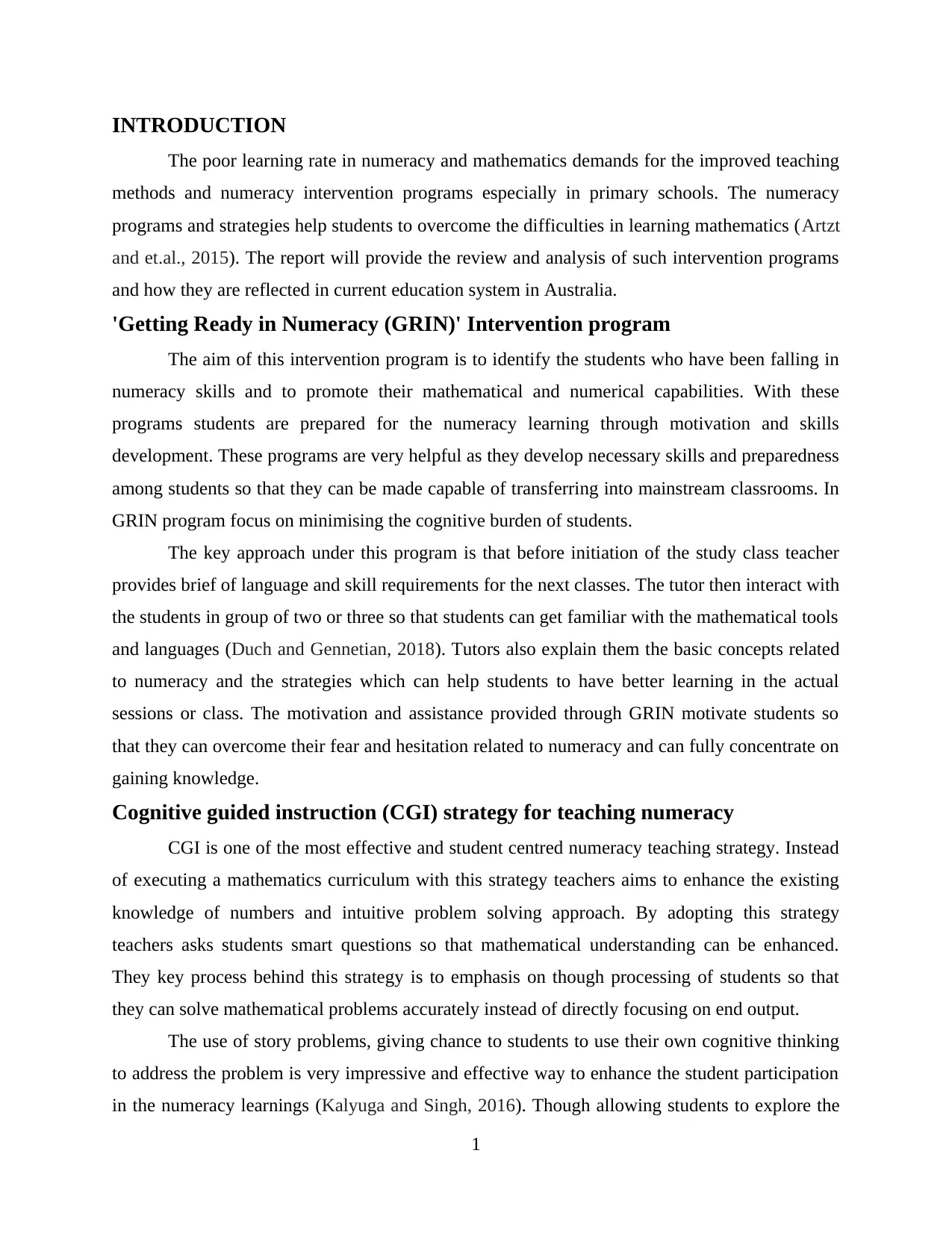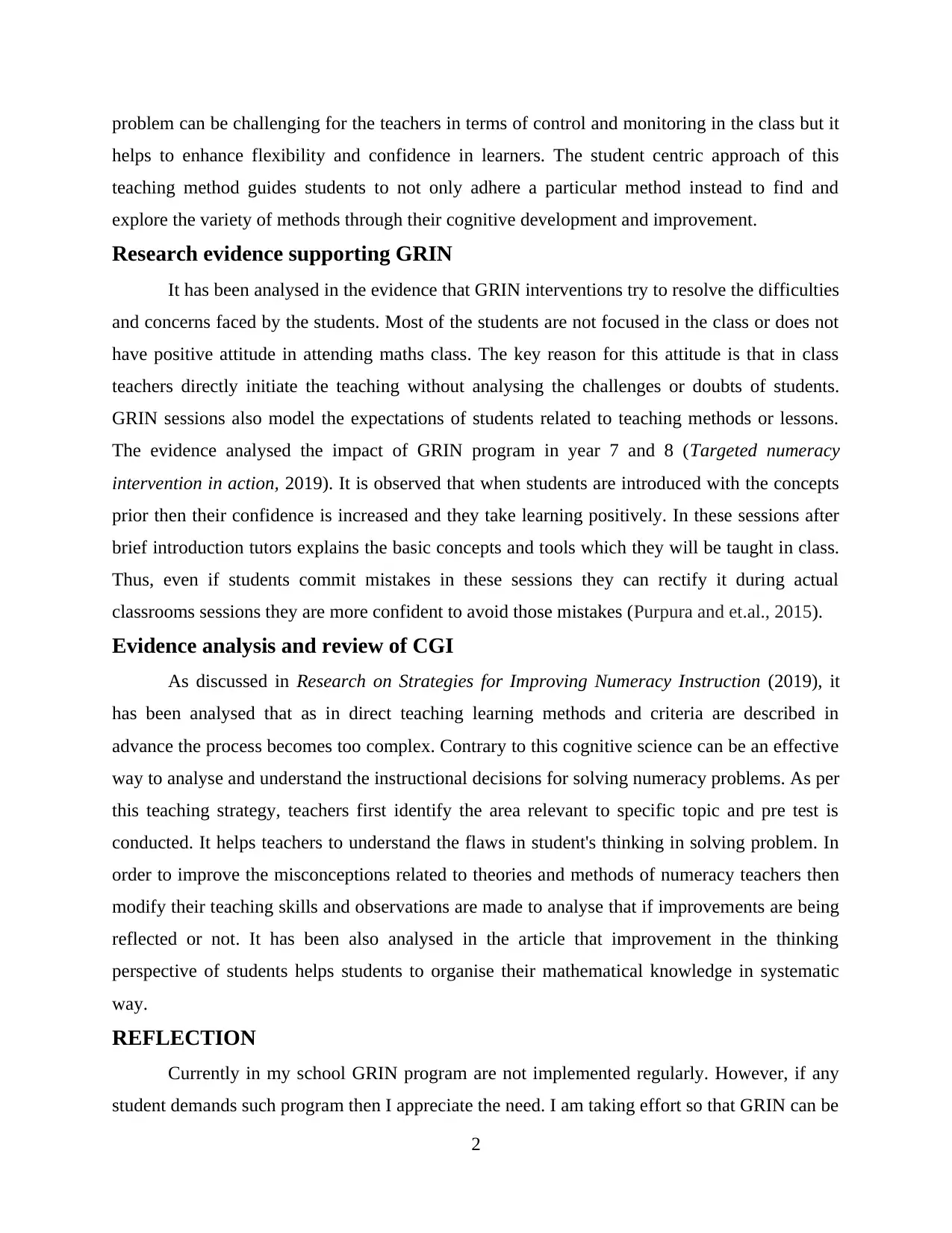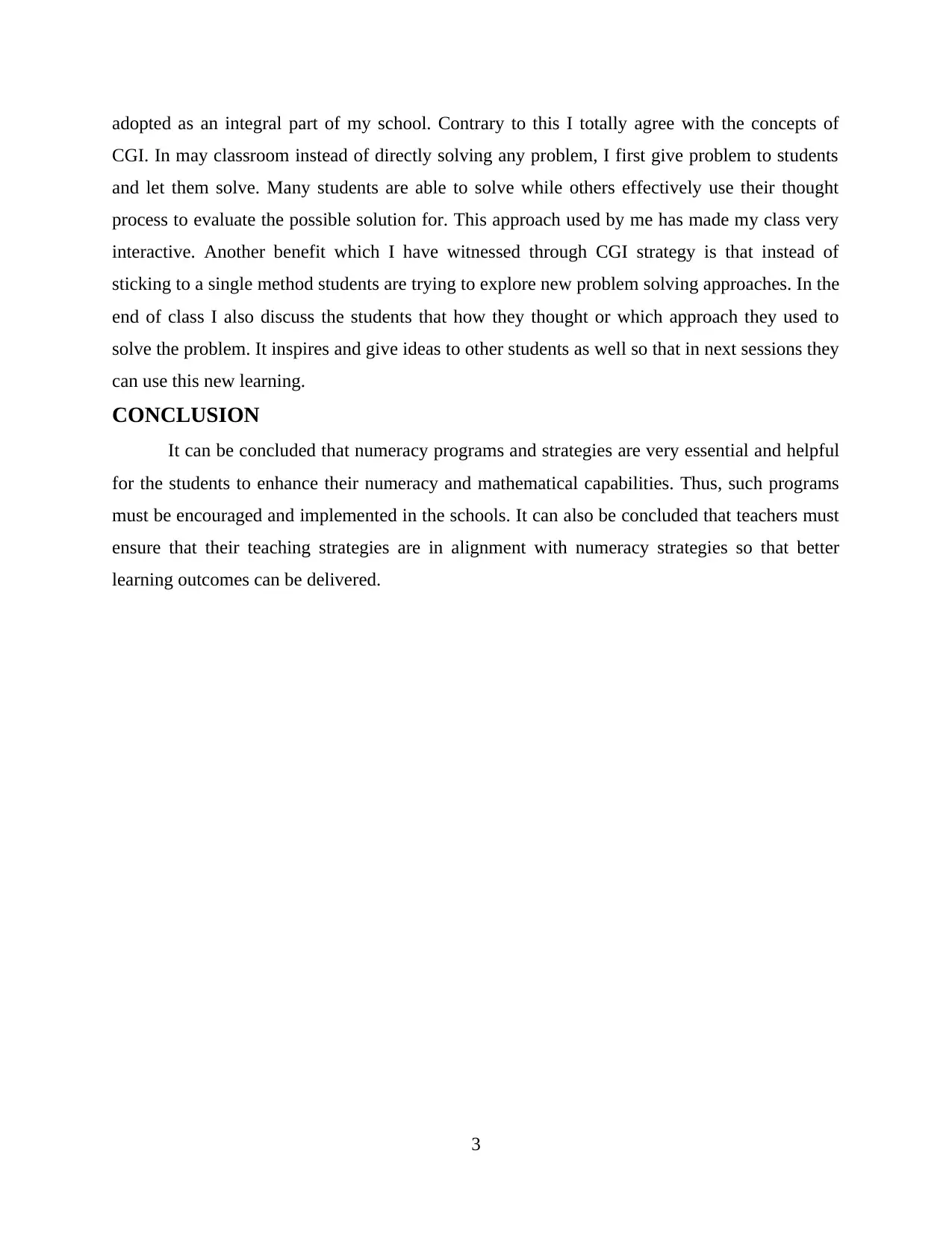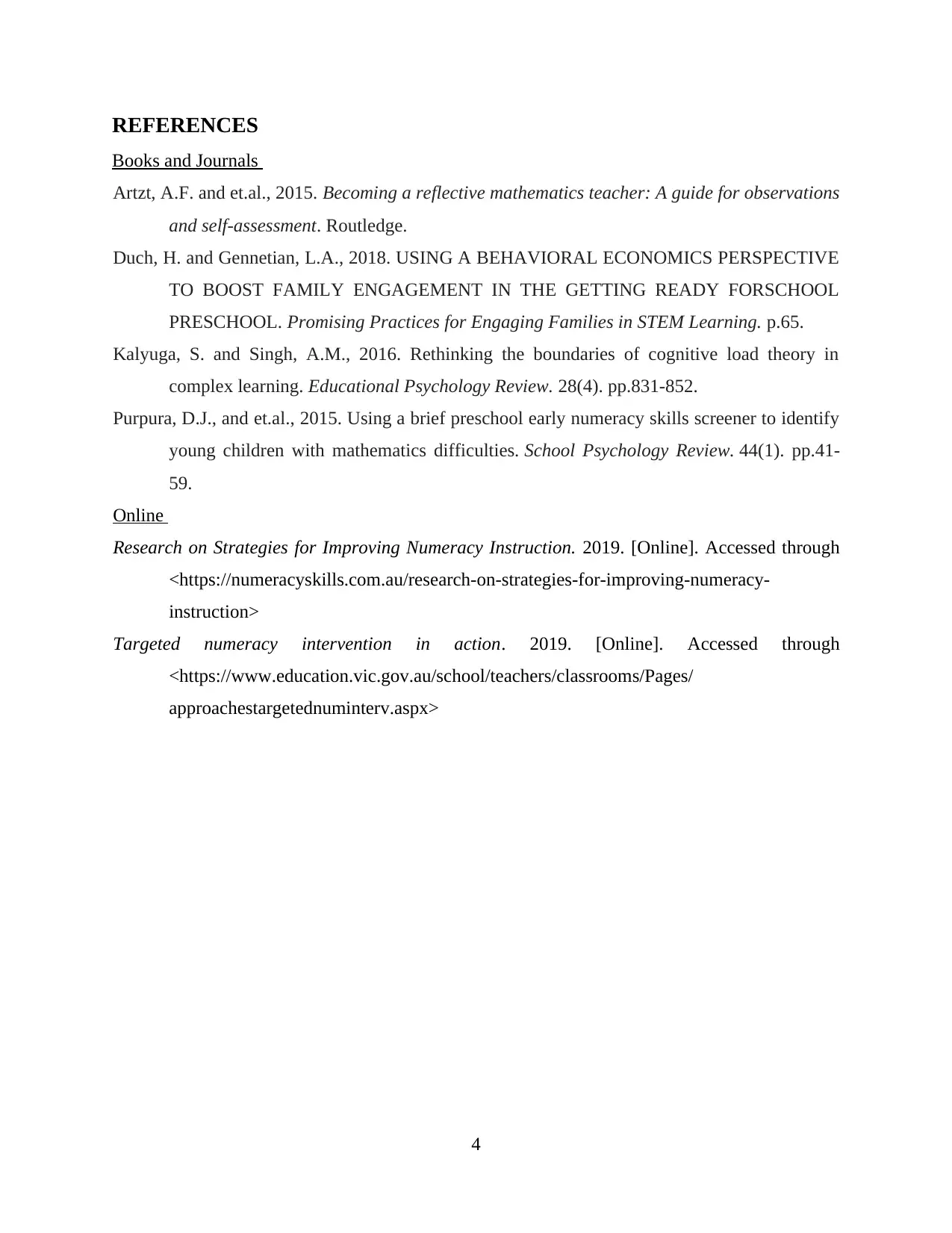Analysis of Numeracy Intervention Programs in Australian Education
VerifiedAdded on 2021/01/09
|10
|1258
|132
Report
AI Summary
This report provides a comprehensive review and analysis of numeracy intervention programs, focusing on their implementation and impact within the Australian education system. It examines two primary intervention strategies: the 'Getting Ready in Numeracy' (GRIN) program, designed to identify and support students struggling with numeracy, and Cognitive Guided Instruction (CGI), a student-centered teaching approach that emphasizes problem-solving and critical thinking. The report discusses the core principles of each program, highlighting how GRIN minimizes cognitive load and prepares students for mainstream classrooms, while CGI encourages students to explore diverse problem-solving methods. It presents research evidence supporting the effectiveness of GRIN in boosting student confidence and engagement, and analyzes how CGI promotes flexible and confident learners. The author reflects on the implementation of these strategies in their own classroom, emphasizing the benefits of student-centered approaches. The report concludes by underscoring the importance of numeracy programs and strategies in enhancing students' mathematical capabilities and advocating for alignment between teaching strategies and numeracy interventions to improve learning outcomes.

Paraphrase This Document
Need a fresh take? Get an instant paraphrase of this document with our AI Paraphraser


INTRODUCTION
The poor learning rate in numeracy and mathematics demands for the improved teaching
methods and numeracy intervention programs especially in primary schools. The numeracy
programs and strategies help students to overcome the difficulties in learning mathematics (Artzt
and et.al., 2015). The report will provide the review and analysis of such intervention programs
and how they are reflected in current education system in Australia.
'Getting Ready in Numeracy (GRIN)' Intervention program
The aim of this intervention program is to identify the students who have been falling in
numeracy skills and to promote their mathematical and numerical capabilities. With these
programs students are prepared for the numeracy learning through motivation and skills
development. These programs are very helpful as they develop necessary skills and preparedness
among students so that they can be made capable of transferring into mainstream classrooms. In
GRIN program focus on minimising the cognitive burden of students.
The key approach under this program is that before initiation of the study class teacher
provides brief of language and skill requirements for the next classes. The tutor then interact with
the students in group of two or three so that students can get familiar with the mathematical tools
and languages (Duch and Gennetian, 2018). Tutors also explain them the basic concepts related
to numeracy and the strategies which can help students to have better learning in the actual
sessions or class. The motivation and assistance provided through GRIN motivate students so
that they can overcome their fear and hesitation related to numeracy and can fully concentrate on
gaining knowledge.
Cognitive guided instruction (CGI) strategy for teaching numeracy
CGI is one of the most effective and student centred numeracy teaching strategy. Instead
of executing a mathematics curriculum with this strategy teachers aims to enhance the existing
knowledge of numbers and intuitive problem solving approach. By adopting this strategy
teachers asks students smart questions so that mathematical understanding can be enhanced.
They key process behind this strategy is to emphasis on though processing of students so that
they can solve mathematical problems accurately instead of directly focusing on end output.
The use of story problems, giving chance to students to use their own cognitive thinking
to address the problem is very impressive and effective way to enhance the student participation
in the numeracy learnings (Kalyuga and Singh, 2016). Though allowing students to explore the
1
The poor learning rate in numeracy and mathematics demands for the improved teaching
methods and numeracy intervention programs especially in primary schools. The numeracy
programs and strategies help students to overcome the difficulties in learning mathematics (Artzt
and et.al., 2015). The report will provide the review and analysis of such intervention programs
and how they are reflected in current education system in Australia.
'Getting Ready in Numeracy (GRIN)' Intervention program
The aim of this intervention program is to identify the students who have been falling in
numeracy skills and to promote their mathematical and numerical capabilities. With these
programs students are prepared for the numeracy learning through motivation and skills
development. These programs are very helpful as they develop necessary skills and preparedness
among students so that they can be made capable of transferring into mainstream classrooms. In
GRIN program focus on minimising the cognitive burden of students.
The key approach under this program is that before initiation of the study class teacher
provides brief of language and skill requirements for the next classes. The tutor then interact with
the students in group of two or three so that students can get familiar with the mathematical tools
and languages (Duch and Gennetian, 2018). Tutors also explain them the basic concepts related
to numeracy and the strategies which can help students to have better learning in the actual
sessions or class. The motivation and assistance provided through GRIN motivate students so
that they can overcome their fear and hesitation related to numeracy and can fully concentrate on
gaining knowledge.
Cognitive guided instruction (CGI) strategy for teaching numeracy
CGI is one of the most effective and student centred numeracy teaching strategy. Instead
of executing a mathematics curriculum with this strategy teachers aims to enhance the existing
knowledge of numbers and intuitive problem solving approach. By adopting this strategy
teachers asks students smart questions so that mathematical understanding can be enhanced.
They key process behind this strategy is to emphasis on though processing of students so that
they can solve mathematical problems accurately instead of directly focusing on end output.
The use of story problems, giving chance to students to use their own cognitive thinking
to address the problem is very impressive and effective way to enhance the student participation
in the numeracy learnings (Kalyuga and Singh, 2016). Though allowing students to explore the
1
⊘ This is a preview!⊘
Do you want full access?
Subscribe today to unlock all pages.

Trusted by 1+ million students worldwide

problem can be challenging for the teachers in terms of control and monitoring in the class but it
helps to enhance flexibility and confidence in learners. The student centric approach of this
teaching method guides students to not only adhere a particular method instead to find and
explore the variety of methods through their cognitive development and improvement.
Research evidence supporting GRIN
It has been analysed in the evidence that GRIN interventions try to resolve the difficulties
and concerns faced by the students. Most of the students are not focused in the class or does not
have positive attitude in attending maths class. The key reason for this attitude is that in class
teachers directly initiate the teaching without analysing the challenges or doubts of students.
GRIN sessions also model the expectations of students related to teaching methods or lessons.
The evidence analysed the impact of GRIN program in year 7 and 8 (Targeted numeracy
intervention in action, 2019). It is observed that when students are introduced with the concepts
prior then their confidence is increased and they take learning positively. In these sessions after
brief introduction tutors explains the basic concepts and tools which they will be taught in class.
Thus, even if students commit mistakes in these sessions they can rectify it during actual
classrooms sessions they are more confident to avoid those mistakes (Purpura and et.al., 2015).
Evidence analysis and review of CGI
As discussed in Research on Strategies for Improving Numeracy Instruction (2019), it
has been analysed that as in direct teaching learning methods and criteria are described in
advance the process becomes too complex. Contrary to this cognitive science can be an effective
way to analyse and understand the instructional decisions for solving numeracy problems. As per
this teaching strategy, teachers first identify the area relevant to specific topic and pre test is
conducted. It helps teachers to understand the flaws in student's thinking in solving problem. In
order to improve the misconceptions related to theories and methods of numeracy teachers then
modify their teaching skills and observations are made to analyse that if improvements are being
reflected or not. It has been also analysed in the article that improvement in the thinking
perspective of students helps students to organise their mathematical knowledge in systematic
way.
REFLECTION
Currently in my school GRIN program are not implemented regularly. However, if any
student demands such program then I appreciate the need. I am taking effort so that GRIN can be
2
helps to enhance flexibility and confidence in learners. The student centric approach of this
teaching method guides students to not only adhere a particular method instead to find and
explore the variety of methods through their cognitive development and improvement.
Research evidence supporting GRIN
It has been analysed in the evidence that GRIN interventions try to resolve the difficulties
and concerns faced by the students. Most of the students are not focused in the class or does not
have positive attitude in attending maths class. The key reason for this attitude is that in class
teachers directly initiate the teaching without analysing the challenges or doubts of students.
GRIN sessions also model the expectations of students related to teaching methods or lessons.
The evidence analysed the impact of GRIN program in year 7 and 8 (Targeted numeracy
intervention in action, 2019). It is observed that when students are introduced with the concepts
prior then their confidence is increased and they take learning positively. In these sessions after
brief introduction tutors explains the basic concepts and tools which they will be taught in class.
Thus, even if students commit mistakes in these sessions they can rectify it during actual
classrooms sessions they are more confident to avoid those mistakes (Purpura and et.al., 2015).
Evidence analysis and review of CGI
As discussed in Research on Strategies for Improving Numeracy Instruction (2019), it
has been analysed that as in direct teaching learning methods and criteria are described in
advance the process becomes too complex. Contrary to this cognitive science can be an effective
way to analyse and understand the instructional decisions for solving numeracy problems. As per
this teaching strategy, teachers first identify the area relevant to specific topic and pre test is
conducted. It helps teachers to understand the flaws in student's thinking in solving problem. In
order to improve the misconceptions related to theories and methods of numeracy teachers then
modify their teaching skills and observations are made to analyse that if improvements are being
reflected or not. It has been also analysed in the article that improvement in the thinking
perspective of students helps students to organise their mathematical knowledge in systematic
way.
REFLECTION
Currently in my school GRIN program are not implemented regularly. However, if any
student demands such program then I appreciate the need. I am taking effort so that GRIN can be
2
Paraphrase This Document
Need a fresh take? Get an instant paraphrase of this document with our AI Paraphraser

adopted as an integral part of my school. Contrary to this I totally agree with the concepts of
CGI. In may classroom instead of directly solving any problem, I first give problem to students
and let them solve. Many students are able to solve while others effectively use their thought
process to evaluate the possible solution for. This approach used by me has made my class very
interactive. Another benefit which I have witnessed through CGI strategy is that instead of
sticking to a single method students are trying to explore new problem solving approaches. In the
end of class I also discuss the students that how they thought or which approach they used to
solve the problem. It inspires and give ideas to other students as well so that in next sessions they
can use this new learning.
CONCLUSION
It can be concluded that numeracy programs and strategies are very essential and helpful
for the students to enhance their numeracy and mathematical capabilities. Thus, such programs
must be encouraged and implemented in the schools. It can also be concluded that teachers must
ensure that their teaching strategies are in alignment with numeracy strategies so that better
learning outcomes can be delivered.
3
CGI. In may classroom instead of directly solving any problem, I first give problem to students
and let them solve. Many students are able to solve while others effectively use their thought
process to evaluate the possible solution for. This approach used by me has made my class very
interactive. Another benefit which I have witnessed through CGI strategy is that instead of
sticking to a single method students are trying to explore new problem solving approaches. In the
end of class I also discuss the students that how they thought or which approach they used to
solve the problem. It inspires and give ideas to other students as well so that in next sessions they
can use this new learning.
CONCLUSION
It can be concluded that numeracy programs and strategies are very essential and helpful
for the students to enhance their numeracy and mathematical capabilities. Thus, such programs
must be encouraged and implemented in the schools. It can also be concluded that teachers must
ensure that their teaching strategies are in alignment with numeracy strategies so that better
learning outcomes can be delivered.
3

REFERENCES
Books and Journals
Artzt, A.F. and et.al., 2015. Becoming a reflective mathematics teacher: A guide for observations
and self-assessment. Routledge.
Duch, H. and Gennetian, L.A., 2018. USING A BEHAVIORAL ECONOMICS PERSPECTIVE
TO BOOST FAMILY ENGAGEMENT IN THE GETTING READY FORSCHOOL
PRESCHOOL. Promising Practices for Engaging Families in STEM Learning. p.65.
Kalyuga, S. and Singh, A.M., 2016. Rethinking the boundaries of cognitive load theory in
complex learning. Educational Psychology Review. 28(4). pp.831-852.
Purpura, D.J., and et.al., 2015. Using a brief preschool early numeracy skills screener to identify
young children with mathematics difficulties. School Psychology Review. 44(1). pp.41-
59.
Online
Research on Strategies for Improving Numeracy Instruction. 2019. [Online]. Accessed through
<https://numeracyskills.com.au/research-on-strategies-for-improving-numeracy-
instruction>
Targeted numeracy intervention in action. 2019. [Online]. Accessed through
<https://www.education.vic.gov.au/school/teachers/classrooms/Pages/
approachestargetednuminterv.aspx>
4
Books and Journals
Artzt, A.F. and et.al., 2015. Becoming a reflective mathematics teacher: A guide for observations
and self-assessment. Routledge.
Duch, H. and Gennetian, L.A., 2018. USING A BEHAVIORAL ECONOMICS PERSPECTIVE
TO BOOST FAMILY ENGAGEMENT IN THE GETTING READY FORSCHOOL
PRESCHOOL. Promising Practices for Engaging Families in STEM Learning. p.65.
Kalyuga, S. and Singh, A.M., 2016. Rethinking the boundaries of cognitive load theory in
complex learning. Educational Psychology Review. 28(4). pp.831-852.
Purpura, D.J., and et.al., 2015. Using a brief preschool early numeracy skills screener to identify
young children with mathematics difficulties. School Psychology Review. 44(1). pp.41-
59.
Online
Research on Strategies for Improving Numeracy Instruction. 2019. [Online]. Accessed through
<https://numeracyskills.com.au/research-on-strategies-for-improving-numeracy-
instruction>
Targeted numeracy intervention in action. 2019. [Online]. Accessed through
<https://www.education.vic.gov.au/school/teachers/classrooms/Pages/
approachestargetednuminterv.aspx>
4
⊘ This is a preview!⊘
Do you want full access?
Subscribe today to unlock all pages.

Trusted by 1+ million students worldwide

5
Paraphrase This Document
Need a fresh take? Get an instant paraphrase of this document with our AI Paraphraser

6

7
⊘ This is a preview!⊘
Do you want full access?
Subscribe today to unlock all pages.

Trusted by 1+ million students worldwide

8
1 out of 10
Related Documents
Your All-in-One AI-Powered Toolkit for Academic Success.
+13062052269
info@desklib.com
Available 24*7 on WhatsApp / Email
![[object Object]](/_next/static/media/star-bottom.7253800d.svg)
Unlock your academic potential
Copyright © 2020–2025 A2Z Services. All Rights Reserved. Developed and managed by ZUCOL.





